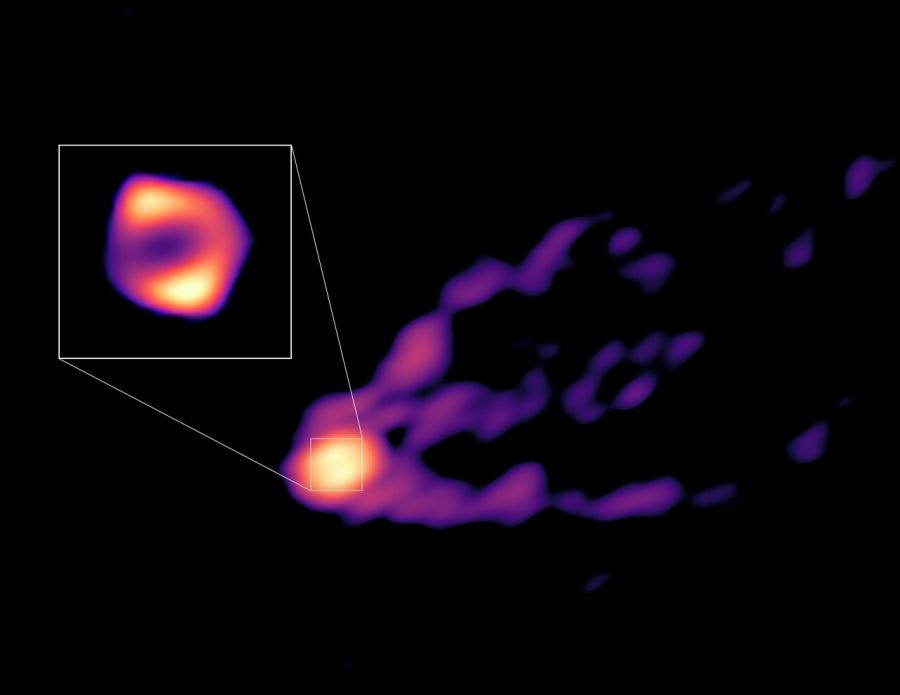In May 2022, the Event Horizon Telescope (EHT) team released the first-ever radio image of M87’s central black hole. It was a stunning revelation based on observations made using a worldwide array of radio telescopes. Recently, they re-released a newer, sharper image of the black hole’s “ring of light.”
Now, a team of astronomers from Europe, Korea, and China, have taken things a step further. This week, they released another amazing view of this monster, this time, in a slightly different range of radio emissions. It clearly shows the connection between the supermassive black hole, its light ring, and the famous high-speed jet.
This latest image was made using an extensive array of radio telescopes. They comprised the Global mm Very Large Baseline Array (GMVA), the Atacama Large Millimeter Array (ALMA), and the Greenland Telescope (GLT). Their combined observations showed very small details in the region around the galactic core. It’s the first time all three major parts of the object are in the same image.
The observations, taken in 2018, show the region in radio light emitted at a longer wavelength than the EHT image. It’s at 3.5 mm instead of 1.3 mm. “At this wavelength, we can see how the jet emerges from the ring of emission around the central supermassive black hole,” says Thomas Krichbaum of the Max Planck Institute for Radio Astronomy. The material streaming away from M87 is an astrophysical jet. It contains superheated (ionized) matter flowing out at high speed along an axis of rotation.

Getting the Big Picture of the Black Hole
To understand the structures in the latest image, we need to know more about them. We know that supermassive black holes in the cores of galaxies are tremendously strong gravitational wells. Nothing can escape because they pretty much suck in everything in the neighborhood. The formation of these monsters is still not well understood. But, we can observe what they do to their neighborhoods.
In the case of M87, there’s an accretion disk funneling material into the black hole. On the other hand, the jet helps some materials to escape. Understanding how such an enormous jet can get created is a longstanding problem in astronomy. It probably forms as a result of some kind of activity inside the surrounding accretion disk.
The jet formation likely also involves tangled magnetic fields. However, astronomers are still unclear on all the details. “We know that jets are ejected from the region surrounding black holes,” said Ru-Sen Lu from the Shanghai Astronomical Observatory in China, “but we still do not fully understand how this actually happens. To study this directly we need to observe the origin of the jet as close as possible to the black hole.”
The new image also shows how the base of the jet connects with the disk of matter swirling into the black hole. Previous observations showed separate views of that disk and the jet. So, this is the first time both features have been observed together. “This new image completes the picture by showing the region around the black hole and the jet at the same time,” said team member Jae-Young Kim from the Kyungpook National University in South Korea and the Max Planck Institute for Radio Astronomy in Germany.
Probing the Ring
The ring of light surrounding M87’s supermassive black hole is another fascinating part of the study. It’s actually something of an optical illusion. As matter orbits around, it gets heated by friction with other matter, and by interactions with the magnetic fields. That causes it to emit light. The strong gravitational effect of the black hole bends and captures some of the light. That creates what looks like a ring. We can see it in the EHT image of M87’s black hole.

The new observations of the ring were made in 2018 and are now being released along with a paper (below) discussing the science. The size of the ring observed by the GMVA network is roughly 50% larger in comparison to the EHT image. “To understand the physical origin of the bigger and thicker ring, we had to use computer simulations to test different scenarios,” explained Keiichi Asada from the Academia Sinica in Taiwan. The results suggest the new image reveals more of the material that is falling toward the black hole than what could be observed with the EHT.
More Observations Planned for M87’s Black Hole
This new observation of the jet and the black hole is the first next-generation view of the system. Future studies will continue with networks of radio telescopes ganged together. They’ll continue probing the connection between black holes and their jets. “We plan to observe the region around the black hole at the center of M87 at different radio wavelengths to further study the emission of the jet,” noted Eduardo Ros from the Max Planck Institute for Radio Astronomy.
Simultaneous observations using this array and the EHT would allow the team to disentangle all the complex actions that occur near the supermassive black hole. Not only will they be interested in the jet, but also the physics and activities of the accretion disk where the jet launches. “The coming years will be exciting, as we will be able to learn more about what happens near one of the most mysterious regions in the Universe,” said Ros.
For More Information
First Direct Image of a Black Hole Expelling a Powerful Jet
A Ring-like Accretion Structure in M87 Connecting Its Black Hole and Jet

